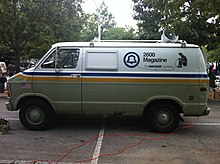2600: The Hacker Quarterly
ISSN 0749-3851 | | |
2600: The Hacker Quarterly is an American seasonal publication of technical information and articles, many of which are written and submitted by the readership, on a variety of subjects including
With origins in the phone phreaking community and late 20th-century counterculture, 2600 and its associated conference transitioned to coverage of modern hacker culture, and the magazine has become a platform for speaking out against increased digital surveillance and advocacy of personal and digital freedoms.[1][2]
Publication history
The magazine's name comes from the
The magazine traces its origins to early
Goldstein has published a compilation of articles from the magazine entitled The Best of 2600: A Hacker Odyssey. The book, an 888-page hardcover, has been available from July 28, 2008, in the US and August 8, 2008, in the UK and is published by Wiley.[7]
"Hacker" term
In the usage of 2600 and affiliates, the often
Conferences and meetings

2600 established the
There are monthly meetings in over 24 countries. The meetings are listed in the back of the magazine, and are advertised as being open to anyone regardless of age or level of expertise.[citation needed]
In other media
2600 Films produced a feature-length documentary about famed
Corley is also host of Off The Wall and Off the Hook, two New York talk radio shows. Both shows can be downloaded or streamed via the 2600 site, and are also broadcast on various radio stations:
- Off the Hook is broadcast on WBAI (99.5 FM)
- Off The Wall is broadcast on WUSB (90.1 FM).
In the 1995 movie Hackers, a character named Emmanuel Goldstein, also known as "Cereal Killer", was portrayed by Matthew Lillard.
Court cases
2600 has been involved in many court cases related to technology and
The magazine itself received a copyright claim for the ink spatter stock image featured on the Spring 2012 issue from Trunk Archive, an image licensing agency, using an automated image tracking toolkit. While Trunk Archive identified its own image that featured the ink spatter as the source, it was discovered that the original ink spatter was created by the Finnish artist Jukka Korhonen,[12] on DeviantArt, who had released it into the public domain.[13] Trunk Archive later retracted the claim and sent a letter to 2600 apologizing for the mistake.[14]
See also
- Media portal
References
- ^ ISSN 0028-792X. Retrieved June 5, 2016.
- ^ a b Jack Bratich. "2600: The Hacker Quarterly". Encyclopædia Britannica. Retrieved December 17, 2015.
- ^ interview with David Ruderman
- ISBN 0-553-56370-X.
- ^ "2600: The Hacker Quarterly : History of Information". www.historyofinformation.com. Retrieved December 26, 2022.
- ^ "NYS Corporation". Appext20. March 19, 1984. Retrieved June 7, 2014.
- ISBN 0-470-29419-1
- ^ "'Hackers are necessary': Q&A with Emmanuel Goldstein of 2600: The Hacker's Quarterly". www.crime-research.org. Retrieved June 5, 2016.
- ^ "Plugging a security leak - Silicon Valley Business Journal". Silicon Valley Business Journal. Retrieved June 5, 2016.
- ^ "Off the Hook 09/12/06". 2600 Enterprises.
- ^ "Copyright fight comes to an end". CNET. Retrieved June 5, 2016.
- ^ "Loadus". DeviantArt. Retrieved January 10, 2018.
- ^ Storm, Darlene (September 10, 2015). "Hacker magazine 2600 extorted for $714 over ink spot pic copyright troll doesn't own". Computerworld. Retrieved May 28, 2016.
- ^ "AN APOLOGY FROM TRUNK ARCHIVE | 2600". www.2600.com. Archived from the original on May 23, 2016. Retrieved May 28, 2016.
External links
- Official website
- ISSN 0749-3851
- 2600 Index or 2600 Index mirror a searchable index of 2600 The Hacker Quarterly magazine article information.
